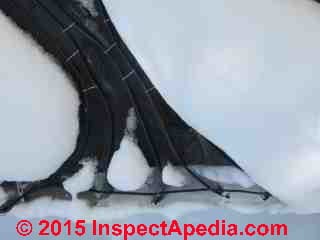How to Install Heat Tape on a Roof
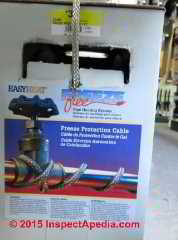 Where & How to Add Heat or Insulation to Prevent Frozen Pipes
Where & How to Add Heat or Insulation to Prevent Frozen Pipes
Heating cables or tapes for pipe freeze protection
- POST a QUESTION or COMMENT about how to protect buildings from freeze damage: prevent frozen pipes, frost heaves, cracking due to freezing, and prevent water and mold damage that follows frozen, burst pipes.
InspectAPedia tolerates no conflicts of interest. We have no relationship with advertisers, products, or services discussed at this website.
Freeze-protection for buildings: pipe heat tapes, pipe heat cables, and self-regulating pipe heating trace cables are described here.
This article explains where, why, and how to add heat at cold problem spots to avoid freezing pipes - both supply pipes and drain pipes. We also point to information on using heating cables on heating oil piping and in in other locations. We discuss the safe use of heat tapes in buildings and warn about unsafe heating tapes and fire hazards.
We also provide an ARTICLE INDEX for this topic, or you can try the page top or bottom SEARCH BOX as a quick way to find information you need.
Guide to Using Heat Tapes & Cables to Protect Pipes From Freezing
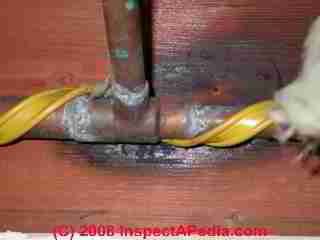
The articles at this website will answer most questions about freeze protection for piping and other building plumbing and heating system components: how to winterize a building to avoid frozen pipes, and how to thaw frozen water supply & drain piping, wells, & water tanks.
We discuss various methods to give each spot in danger of freezing its own heat source.
For example simple passive heating may be sufficient to avoid freezing in some locations: in kitchens and bathrooms we may leave open vanity cabinet doors to permit warmer building air to reach pipes in those areas.
Our photo shows both a plumbing repair (charred joist, sloppy soldering) and a yellow heat tape in use.
[Click to enlarge any image]
What can we infer about the building's frozen pipe history from this photo?
Answers are in the article below.
Article Series Contents
- HEAT TAPES to AVOID FROZEN PIPES
- HEAT TAPE TYPES - heat tape vs. heat cable vs. heat trace cable vs indoor vs outdoor use etc.
- HEAT TAPES on PLASTIC PIPE
- HEAT TAPE SAFETY WARNINGS
- GFCIs & AFCIs for HEAT TAPE SAFETY
- INSULATION as PIPE FREEZE PROTECTION
- LOCATIONS for HEAT TAPES for FREEZE PROTECTION - where to put heating tapes
- LOCATING HEAT TAPES in CONCEALED SPACES? - don't do it
- PIPE FREEZE PROTECTION CABLE ASSEMBLY & CUSTOM LENGTHS - separate article
- SUMP PUMP FREEZE PROTECTION
Using heat tapes to protect pipes from freezing: heat tapes are one of the simplest and more commonly used methods of protecting sections of water pipes from freezing.
The photograph of the yellow heat tape above [Click to enlarge any image] contains some helpful information:
- The presence of a heat tape indoors indicates that someone has already had reason to be concerned about freezing pipes in this area of the building.
- The insulation, in the right edge of the photo, if it is wrapped around the pipe to cover the heating tape, can create a fire hazard by causing the heat tape to overheat when it is in use.
- The charred joist behind the copper piping in this photo has nothing to do with the heat tape itself, was not caused by the heat tape, and was almost certainly caused during soldering of the pipe tee to the three copper lines - the plumber didn't bother to place a heat shield behind the piping to protect the wood.
However it's possible that this solder job indicates previous repairs on frozen pipes in this area.
How to Choose the Right Type of Heating Cable for Protecting Water or Drain Pipes vs. Roof Ice Dams
What's the Difference Between a Pipe Heat Tape & Pipe Heat Cable?

Normal people call all of these pipe freeze protection heating devices pipe heat cables, pipe heat tapes, or heat trace cables, mixing the terms without a worry. But technically these are three different products.
Photo above: a pipe heating tape used for freeze protection, showing its adjustable thermostat and the flat, flexible properties of the heating tape. This heating tape is produced by Briskhet and is sold by plumbing and building suppliers and online vendors like grainger.com .
- Pipe heat tapes are flat and flexible and usually of limited length; These flat devices are "heat tapes" and are more-flexible - easy to wrap on pipe and have good contact between the heater and the pipe surface.
Watch out: if your pipe heating tape is not wrapped snugly around the pipe so that it is in good physical contact it may fail to protect the pipe against freezing.
- Pipe heating cables are usually round, available in very long lengths, often sold with user-installed wall plug and end termination temperature sensor to permit use in custom lengths.
Pipe heating cables are sometimes wrapped in stainless steel braid for extra protection. Heating cable or pipe heat trace cable is less-flexible than a pipe heat tape, and often has higher heat output. A pipe heating cable need not be wrapped as snugly on a pipe.
- Pipe heat trace cable is a synonym for pipe heating cable.
Both pipe heat tapes and pipe heat trace cable that use a constant wattage require a temperature regulating device to prevent the heating tape/cable from overheating and burning-out. Usually that controller includes a temperature sensor found at one end of the tape or cable.

- Self-regulating pipe heat trace cable is designed to limit current flow so that it won't get hotter than its design temperature - a safety feature.
There are versions of these pipe freeze-protection tapes or cables that are intended to be left exposed and others intended to be insulated -over (though I think of heat tapes more in this case) but by normal people the terms are used interchangeably.
Indoor vs. Outdoor, Roof vs Pipe Freeze Protection Tapes & Cables
Watch out: buy the correct kind of heating tape or cable. Don't try to use a cable designed for protecting pipes from freezing up on a roof as an ice dam measure. And similarly, don't use a roof heating cable designed to roof ice dam leaks on a building plumbing pipe.
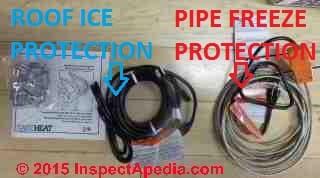 Shown at left in our photo (blue arrow) is a roof heating cable intended for outdoor use. This cable is waterproof. It is not designed to be used on pipes and is not designed to be covered with insulation.
Shown at left in our photo (blue arrow) is a roof heating cable intended for outdoor use. This cable is waterproof. It is not designed to be used on pipes and is not designed to be covered with insulation.
Shown at right in the same photo (red arrow) is a braided metal-covered heat tape or cable. While you can also purchase pre-made pipe heating cables, this model is can be made to any length needed.
But this braided metal cable heat tape and its connectors are intended for use only indoors in a dry location and are designed to prevent pipes from freezing.
Pipe heating/ freeze-preventing cables to avoid frozen pipes (at right in the photo above) are discussed on this page, continuing below. Heating cables for building supply or drain pipes are wrapped around the pipe in sections of piping prone to freezing. In this article series we give other methods for avoiding frozen pipes such as sealing drafts
see PIPE FREEZE-UP POINTS
and also adding heat by other means than heat tapes
see HEAT SOURCES to AVOID FROZEN PIPES.
Roof & gutter de-icing heating cables for ice dam protection (at left in the photo above and shown installed on a low-slope roof in an ice problem area just below) are discussed
at HEAT TAPES & CABLES for ROOF ICE DAMS
Avoid a fire hazard with heating tapes
Watch out: if the heat tape or cable is not correctly installed it can be a fire hazard (as well as unreliable). Heat tape safety suggestions from the US CPSC are offered below.
Heating tapes work fine on copper, brass, or galvanized iron piping, for both supply and drain piping but we prefer the type that use an automatic thermostat so that we are not using electricity unnecessarily.
Be sure that the heat tape is properly installed and that you don't cover the thermostat nor place it in a warm rather than cold spot on the piping.
How to Install Heating Tapes on Plastic or PVC Supply or Drain Piping
If your building plumbing pipes are plastic, such as PVC water piping, use only pipe heat tape that has an automatic thermostat to control the heat tape temperature. Otherwise a very hot heating tape may damage the piping or even cause a leak.
Watch out: some heating tapes cannot safely be used on drain pipes, particularly PVC piping, possibly because of a concern for heat damage to the piping. Be sure to check with the manufacturer about the intended application of their heating tape.
The tape installation specs for PVC or other plastic piping may specify the spacing used when spiraling the heat tape around the pipe to avoid any risk of overheating.
Be sure to read PIPE HEAT TAPE SAFETY GUIDE from the US CPSC
Several manufacturers provide pipe heating cables that can be used on all types of piping materials including plastic or PVC, but be sure to read the instructions. Depending on the pipe material, different heat tape installation procedures are recommended. Here are some examples provided by Easy Heat®.
The company also provides an electrical receptacle adapter that provides thermostatic control to turn the heating cable on and off as needed. [9] Other heating cables that can work in these applications are available from RayChem® [11] and other manufacturers.
Temperature-controlled cable runs straight along pipe and valves, held in place by application tape and plugs into grounded electrical outlet. Keeps water flowing down to -380. For odd lengths of pipe over 3/4 inches in diameter, we recommend two separate cables on opposite sides of the pipe with up to 3 feet of overrun at center of pipe run.
Metal pipe requires 1/2-inch fiberglass insulation around cable.
For plastic pipe, its recommended wrapping pipe with aluminum foil before cable installation.
The traditional resistance cable produces a fixed amount of heat based on the electrical line feed. It comes with a built-in thermostat that switches the flow of electricity on and off based on temperature. 120 volts. 7 watts per foot. Not U.L. Listed. [9]
How to Protect a Sump Pump from Freezing
Sump pump and drain piping freeze protection: for indoor sump pumps and drains follow our advice above regarding metal vs. plastic piping and heat tape selection. If your sump pump drain line is exposed to severe cold above ground outdoors it may be difficult to keep it from freezing.
A common water entry problem we've seen is during spring thaw in northern climates. The ground surface may be frozen but melting snow sends water into building around and through foundation walls, especially if you've shoveled snow piled up against the foundation walls.
If the building is relying on a sump pump to remove foundation water then this is just the time we don't want our sump pump drain to freeze. If the drain can't be buried below the frost line all the way from the building to its final destination, we've had some success using heat cables intended for outdoor and wet conditions, even placing the tape inside the pipe in some installations.
Follow the heating tape manufacturer's instructions and be sure to provide a means of easy tape replacement when needed - you don't want to have to dig up the entire line over again just to replace a heating tape on a sump pump drain.
Heating tape safety and proper installation are discussed just below.
Also see SUMP PUMPS - home
Common Locations for Heating Cables or Tapes to Prevent Pipe Freeze Damage
Common locations where heating tapes are used on plumbing to prevent freezing pipes include:
- Drain pipes: small-diameter, poorly-sloped drain piping in areas exposed to drafts or freezing temperatures. Normally you should not have to protect a drain from freezing but slow drains or drains into which water trickles from dripping faucets or running toilets are prone to freeze damage.
See DRAIN FREEZE PROTECTION
- Heating oil piping where heating oil is stored in outdoor above ground oil storage tanks. -
See HEAT TAPES on OIL TANK PIPING
but
Watch out : also see HEAT TAPE HAZARD ON OIL TANK discussed at articles on oil piping defects and dangers. - Hot water heating boiler supply piping and zone piping & steam boiler water supply lines in areas subject to freezing when heat runs very infrequently or or where heat is set to very low temperatures.
For hydronic or hot water heating systems alsosee ANTIFREEZE for BOILERS
- Sump pump drain lines
See SUMP PUMP FREEZE PROTECTION
- Water heaters, calorifiers, cylinders: piping and tanks are not normally treated with heating tapes or cables; if heat is left off drain the heater.
See DRAIN a WATER HEATER TANK
- Water supply pipes in any area prone to freezing such as where there are building drafts and air leaks at sills in a crawl space, at the rim joist, in other attic and crawl spaces listed below, and below sinks whose piping is enclosed by a cabinet subject to low temperatures.
Pipe Freeze Protection Tip: when leaving your building with heat on but set low, leave all sink cabinet or vanity doors open to permit more heat to enter that space
- Water pipes run through attics, attic knee wall areas, or other un-insulated spaces
- Water pipes run through un-heated crawl spaces
- Water pipes and equipment in un-heated garages
- Water equipment in well pits
- Water softener piping - including supply lines, brine supply and drain lines; it's smarter to drain the softener and brine tank if the building heat is to be left off
See WATER SOFTENER / TREATMENT TURN OFF
- Water pipes running under porches
- Well piping or municipal water supply piping in areas subject to drafts and/or freezing temperatures.
See also this approach to avoiding frozen well piping on some older submersible pump wells:
SNIFTER & DRAIN BACK VALVES
Some older or less costly models of heating tapes present a fire risk, particularly if the heating tape is crossed over itself. Be sure to read the product specifications, safety warnings, and installation guide before installing a heating tape on building piping of any kind.
Pipe Heat Tape Safety Guide from the US CPSC
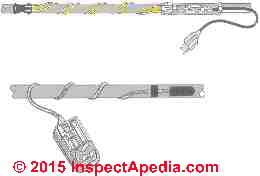
Above our sketch, adapted from US CPSC publications illustrates two different temperature sensor locations: near the plug connector (upper cable and illustrated in the photograph below), and at the tip of the cable (the black sensor tip in the lower cable in the sketch just above).

Just above you can see the temperature sensing bulb of a pipe heating cable and if you look closely you can see the yellow heating tape in the upper right of the photo.
The U.S. CPSC has provided safety recommendations for homeowners using heat tapes to help prevent fires:
- Replace heat tapes that are older than three years
- Use only heat tapes certified to meet recognized voluntary fire safety standards such as those provided by Underwriters Laboratories (UL), the Canadian Standards Association (CSA), and the Factory Mutual Research Corporation (FMRC).
- Plug the grounded (3-prong) plug into a grounded GFCI (ground-fault circuit interrupter) protected electrical outlet
See GFCIs & AFCIs for HEAT TAPE SAFETY
- Don't cross the heat tape across itself unless the manufacturer says that's acceptable - crossed heat tapes can overheat and start a fire
- Put the heating tape on the surface of the pipe to be protected from freezing, not on top of pipe insulation, and do not cover the heating tape with insulation unless the manufacturer says that's acceptable. Use only non-combustible insulation on pipes where heating tapes are installed (like fiberglass insulation). Foam or vinyl pipe insulation may catch on fire from a faulty heat tape or faulty heat tape installation.
- Protect the sealed end-cap of the heat tape (see our photo above) from damage and water leaks which could cause a short circuit or fire.
- Use heating tape only for the application approved for that particular heating tape, such as for use on piping. Some heat tapes are designed for use in gutters or driveways while others are designed for use on piping or fuel piping.
- Be sure that the heat tape thermostat (if one is provided) is placed where the instructions say. For example some heat tape thermostats should be placed in contact with the pipe, others left hanging in air. (See our photo above)
- Replace any heat tape that is discolored (a sign of overheating), cracked, melted, or damaged in any way.
Advice For & Warnings About Using GFCI-protected Circuits or AFCI-protected circuits to Power Heat Tapes to Avoid Fires
Watch out: some models of heat tapes used for freeze protection can cause a building fire if the tapes are not installed according to the manufacturer's recommendations, particularly if the tape crosses over itself.
As Ryan Duffy points out, connecting the heat tape to a GFCI-protected circuit can substantially reduce the risk of heat tape fires.
However if the GFCI-protected heat tape circuit trips-off during typical current leakage conditions and without drawing attention of the building occupants, the risk of freeze damaged piping, leaks, water damage, and mold damage will be increased.
The US CPSC recommended in 1994 [PDF] that HUD consider dropping its no-GFCI-on-Heat-Tape-Circuit provision, and that heat tape powering electrical circuits be be protected with a GFCI device in the electrical panel rather than at the electrical receptacle or "outlet". Ground fault protection was first required in the 1987 NEC for heat tapes that did not have a metal covering.
In 1996/1999 the NEC expanded the requirements for GFCI protection and specified that mobile homes would have at least one heat tape receptacle. [A significant number of heat tape-related fires occurred in mobile and manufactured homes.]
Also see AFCIs ARC FAULT CIRCUIT INTERRUPTERS
- See FREEZE-PROOF A BUILDING where we describe GFCI protection on heat tape circuits powering heat tapes for manufactured and mobile homes.
- Similar issues regarding building water entry control are discussed
at SUMP PUMP INSPECTION
Also see Testing Receptacles GFCIs AFCIs.
AFCI's are discussed
at AFCIs ARC FAULT CIRCUIT INTERRUPTERS.
- We discuss use of heating cables on plumbing supply and drain pipes
at HEAT TAPES to AVOID FROZEN PIPES (this article)
- We discuss where & how to add heat or insulation to prevent frozen pipes
at HEAT SOURCES to AVOID FROZEN PIPES
- Also see HEAT TAPES & CABLES for ROOF ICE DAMS where we describe outdoor use of heating tapes and de-icing cables to prevent ice dam leaks into buildings
Guide to Pipe Insulation to Prevent Freezing
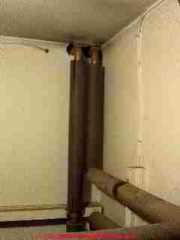
Add Water Pipe insulation to prevent freezing: can be added to protect pipes routed through un-heated areas or near cold building corners. We particularly like to add slip-on foam pipe insulation where a plumbing line is run past a cold spot that is hard to warm up.
Some writers believe that if you insulate all of your water supply piping you won't have a frozen pipe problem.
That may be a bit optimistic: we fear that a cold corner somewhere will be missed and left un insulated, or that a house left without heat for too long will get cold enough to freeze even an insulated pipe.
The advantage of insulating pipes is that it slows the rate at which a water pipe will freeze, possibly getting the pipe through the coldest part of the night and into a (hopefully) warmer daytime to warm-up again.
Remember, when insulating a water pipe, that you need to insulate all of it. Don't leave those awkward elbows or pipe tees un insulated.
Here is a speculative warning about relying on pipe insulation alone to avoid freezing, that is, we don't have hard science to back up this view: Insulation on a water pipe will protect the pipe from freezing during a brief very cold spell.
But during a period of prolonged very cold nights and only moderately warmer days, we wonder if the insulation permits the pipes to accumulate "cold" rather than warmth, ultimately reaching the freezing point.
Plastic piping to resist freezing: modern plastic piping is considerably more tolerant of freezing without bursting than copper or steel water pipes. In a home intended for regular winterization some builders use exclusively plastic pipes to resist freeze damage. Be careful: even when freeze-tolerant piping is used, the piping connections, elbows, unions, couplings, and plumbing fixtures are still at risk of frost damage.
Watch out: even when freeze-tolerant piping is used, the piping connections, elbows, unions, couplings, and plumbing fixtures are still at risk of frost damage.
Reader Comment: Warning: over-insulation of pipes protected by heating tapes can cause freezing
Apparently heavily insulating over a self-regulating heating cable that calls for minimal insulation can be a bad thing.
EasyHeat calls for only 1/2" of fiberglass wrap on their self-regulating pipe heating system, and the safety tag on the product cord says to not over-insulate. So, I called and talked to the tech service guys.
They said that more insulation is not a fire hazard, but while it will keep the heat in, will cause the cable to regulate the heat downward and can then allow the pipe to freeze. The system is designed to keep the pipe from freezing within the engineered temp range without extra insulation.
Interesting contrast to Raychem, that instructs a "minimum" of 1/2" of insulation for their self-regulating FG1 product. Their instructions and on-line images also show using foam pipe insulation, while the safety tag on the product warns to use only non-flammable insulation like fiberglass. EasyHeat also calls for non-flammable insulation.
I'd think the Raychem product would suffer the same downward self-regulation as the EasyHeat product. - George 2021/07/15
This comment was posted originally at HEAT TAPE PIPE PROTECTION FAQs
Moderator reply: un-even insulation on pipes may mean risk of freezing
@George,
RE: Warning: over-insulation of pipes protected by heating tapes can cause freezing
Thank you, that's very interesting and helpful information about just how much insulation to put over heat tapes on pipe.
Really? The manufacturers' instructions are a bit confusing in that heating tapes are installed on pipes in such a wide range of climates.
- In 2021 in New York last winter the lowest January temperature was 5 degF, while in Two Harbors Minnesota the lowest temperature we saw was minus 24 degF.
- Furthermore, if the heating tape's temperature sensor is simply sensing temperature of the pipe or the air very close to the pipe, and if the temperature sensor is properly located, adding a lot of insulation that therefore keeps heat in and around the pipe, ought, by definition, to be keeping the pipe at that temperature, too. So you'd think that as long as the temperature inside the insulation is above freezing the heat tape can run as little or as much as it thinks it should, without a risk of freezing the pipe.
- Where we'd get into trouble is, in my OPINION, where the insulation is un-even. In that case, if the area of heat tape where its temperature sensor is located is insulated more than other sections of the same pipe, we face an obvious freezing risk.
Bottom line for readers: read and follow the manufacturer's instructions when installing a heating tape for freeze protection.
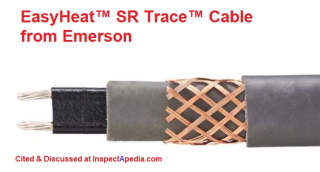
- EASY HEAT HEATING CABLE CATALOG [PDF] (2020) Emerson Products, Emerson US and World Headquarters | Emerson Electric Co. 8000 West Florissant Avenue, P.O. Box 4100, St. Louis , MO 63136, United States Tel: +1 314 553 2000 + 1 888 889 9170 offices world wide, retrieved 2021/07/15 original source: https://www.emerson.com/documents/commercial-residential/easyheat-residential-commercial-solutions-catalog-en-2125080.pdf
Product description: EasyHeat™ SR Trace™ cable is a self-regulating heating cable that provides maximum freeze protection for pipe lines and vessels. The self-regulating heating cable automatically varies its heat output as the surrounding temperature changes. They are ideal for use on commercial metal or plastic water supply and drain pipes subject to freezing; liquids piped during processing that require constant temperatures; and freeze protection for branch sprinkler systems.

- Raychem, nVent HTV SELF REGULATING HEATING CABLE SPECS [PDF] (Heat tracing, pipe freeze protection, and similar applications), 7433 Harwin Drive Houston, TX 77036 USA Tel: 800-545-6258, Website: https://raychem.nvent.com/en-us/
Product description: nVent RAYCHEM HTV self-regulating heating cable is designed for freeze protection or process temperature maintenance of pipes and vessels up to 205°C continuously, with a maximum exposure temperature of 260°C. The HTV cable has a solid construction with a high power retention (HPR) heating core and pressure extruded electrical insulation. It is then integrated with a robust metallic braid and a chemically resistant fluoropolymer outer jacket.
Reader Question: doesn't the use of "self-regulated" heat tape mean I can safely add lots of pipe insulation too?
(Nov 11, 2014) Jera Anderson said:
I've installed two EasyHeat brand heat tapes per the instructions on my PEX lines which are installed in an unheated crawlspace beneath the house. I pre-wrapped all the PEX with aluminum foil, then secured the tape to the pipe with 3" wide aluminum tape. Installation instructions suggested securing with high temp electrical tape or an equivalent.
The manufacturer's documentation warns to use no more than 1/2" non-combustable insulation (fiberglass) wrapped around the installation, then a vapor barrier (plastic wrap) to keep the insulation dry.
My question is this: 1/2" fiberglass seems inadequate to me and wouldn't hold very much heat near the pipe. The warnings are the heat tape can overheat and cause a fire hazard if more than 1/2" is used. Can this type of self-regulated tape (it has its own thermostat and turns off when water temp reaches 40-50 degrees F.) actually generate enough heat to set PEX on fire if more than 1/2" fiberglass is used? Thanks!
Reply: no.
Jera
At the end of the day we are wise to follow the manufacturer's instructions - they have a lot at stake in the successful and safe use of their product. A hazard of improper use of some models of heating tapes is a building fire, while other heating tapes, though protected against short-circuits and fires, may fail to keep the pipe hot enough if over-insulated. While the heat tape may be described as self-regulating, the manufacturer has decided, probably based on testing and UL listing procedures, just what level if insulation is safe with their product.
Therefore if we are in doubt about the adequacy of a single step aimed at avoiding frozen pipes I'd prefer to take other proper steps such as those described in this article series: finding and fixing drafts, or adding area heat for example.
Often we find that even a small amount of heat added in an area, sometimes just an incandescent light bulb, is enough to avoid a freezing problem.
At INSULATION to AVOID FROZEN PIPES we explain that pipe insulation does not always work as expected as a freeze-proofing measure: depending on how ambient temperatures cycle the insulation can also prevent piping from gaining heat during warmer intervals, sometimes actually increasing freeze risk during long cold periods with brief warming intervals.
Assemble a Custom-Length Pipe Heating Cable

[Click to enlarge any image]
The braided-metal-covered indoor-use pipe heating cable show above described here can be purchased in variable lengths from your local plumbing or hardware supplier. The kit includes two cable terminations: a plug-connector and a heat-sensing termination for the other end of the cable.
In some pipe heat tape cable versions the temperature sensor may be located at the plug-end. We bought this top-end do-it-yourself freeze protection cable at Davies Hardware on Main Street in Poughkeepsie, New York but this EasyHeat® brand freeze-free protection cable is widely available from plumbing and building suppliers.
Use of Heat Tapes in Concealed Spaces: Walls, Ceilings, Floors?
Question: can I use a heat cable (not tape) inside of a wall cavity?
2019 09 23 Raymond Cioe said:
Can heat cables , not heat tape , be installed on water supply and plastic drain pipes inside a wall
This question was posted originally at the InspectApedia.com search page and was moved here to assist other readers on the same topic.
Reply: do not install pipe heating cables or tapes in a wall cavity
Raymond
Thank you for asking an important safety question.
I have not found any heating cable nor heat tape product information from a manufacturer that explicitly addresses your question. But there are sources that explicitly say no, such as the OH plumbing code and some model codes.
Difference between a Pipe Heating Cable and Pipe Heating Tape
For other readers, heating cables are sold in varying lengths, voltages and wattages and are installed by adding a temperature controller and closing tip onto the cut cable length. SOME heating cables can be crossed-over one another without overheating or shorting. Typically you're told to add some insulation over the heat cable as it doesn't make as secure a contact with pipe surface as does a more flexible, thinner heat "tape".
Heat Tapes Prohibited in Concealed Spaces
Eg: from the U.S. state of Ohio PLUMBING HEAT TAPES & THE CODES [PDF] Ohio Board of Building Standards, 6606 Tussing Road, P.O. Box 4009, Reynoldsburg, Ohio 43068-9009 USA, BBS Memo, 19 Feb 2015, Original source www.com.ohio.gov/documents/dico_388.pdf
The Plumbing Code Commentary for this section states that, "Where piping is not directly adjacent to heated spaces in a building, electric resistance heat tapes or cables can be used to supply heat to the piping, except in concealed spaces.
Plastic piping requires self-limiting type heat tape to prevent overheating of the pipe." The Plumbing Code commentary states (page 3-8) that "there must always be a heat source along with an appropriate insulation thickness in order to protect pipes from freezing conditions.
Insulation by itself (without a heat source) cannot protect a pipe from freezing." Therefore, it mentions heat tape as being a viable alternative, and that the code provides no guidelines for insulating the pipes without the use of heat trace tape to ensure that piping will not be exposed to freezing.
NEC article 427 classifies heat tape, or heat trace tape, as a resistance heating element. NEC 427 III. Resistance Heating Elements sections 427.14 through 427.23(A) & (B) and 427, VII (427.55 to 427.57) apply as installation requirements for this source of freeze protection.
...
From a practical standpoint, plumbing freeze alarm, heat tape system failure notification devices, and any type of heat trace tape system thermostat controls should be within view by the occupants and maintenance personnel in the occupiable space.
Since crawls spaces and attics are not frequently observed and monitored, without these devices the only notification of system failure is the odor of leaking effluent, a flooded crawl space leaking through the perimeter building "skirt", or water stains in the ceiling below the attic.
See additional details in the document linked just above.
Consumer Product Safety Commission
New Electric Heat Tapes Help Prevent Fires - Safety Alert CPSC Document #5045
To help prevent fires, the U.S. Consumer Product Safety Commission (CPSC) urges homeowners (including residents of mobile homes) to replace uncertified heat tapes more than three years old. Uncertified heat tapes should be replaced with new heat tapes certified to meet recognized voluntary standards. At the present the following organizations are certifying heat tapes to meet recognized voluntary standards: Underwriters Laboratories (UL), the Canadian Standards Association (CSA), and Factory Mutual Research Corporation (FMRC).
Electric heat tapes are used to keep water pipes from freezing. Heat tapes are usually installed in attics or underneath porches and homes, especially mobile homes. CPSC estimates there are about 2,000 fires, 10 deaths, and 100 injuries each year involving heat tapes. The use of certified heat tapes can help to reduce the frequency of these fires.
CPSC offers these safety tips for purchasing, installing, and maintaining electric heat tapes:
Replace uncertified heat tapes more than 3 years old with new heat tapes certified to meet recognized voluntary standards. All new heat tapes will have a 3-prong plug.
Always plug the 3-prong plug into a 3-prong outlet to make sure the heat tape is grounded.
Use a ground-fault circuit-interrupter (GFCI) wherever heat tapes are plugged in.
Do not wrap heat tape over itself unless specifically permitted in the manufacturer's instructions.
Apply heat tapes directly on the pipe to be protected, never on top of the insulation covering the pipe.
Do not cover the heat tape with insulation unless advised by the manufacturer. Use nonflammable insulation such as fiber glass. Do not use foam or vinyl insulation that could catch fire from a failing heat tape.
Keep the end-cap sealed and off the ground to prevent water from getting in. Moisture can lead to a fire.
Do not use heat tapes designed for water pipes on gutters, driveways, or fuel lines.
If heat tape has a thermostat, check instructions to see if the thermostat should be placed against the pipe and covered with insulation or if it should be left hanging and uncovered.
Inspect heat tapes each year and replace them if you notice signs of deterioration. Look for discolored surfaces (especially at the plug), charring, cuts or breaks in the insulation, or bare wires.
Check installation instructions when you change types or brands of heat tape because different heat tapes have different installation requirements.
----
From the US CPSC www.cpsc.gov/content/inspect-heat-tapes-cables-as-you-winterize-your-home - released 27 Sept 1989 here are the CPSC recommendations for Heat Tape Installatin
Release Details
If you use electric heat tapes or pipe heating cables under your home to protect pipes from freezing, government safety experts want you to check the tapes or cables now for possible fire hazards before winter sets in.
In a safety alert directed at mobile home dwellers and owners of dwellings with exposed sub-structures, the U.S. Consumer Product Safety Commission (CPSC) said heat tapes and pipe heating cables should be inspected each fall for hazards which could trigger a fire. CPSC said tapes and cables are involved in some 3,300 residential fires each year.
The safety agency offered the following safety tips:
-- Unplug the heat tape or cable first, then check the entire length of the tape for signs of cracked or charred insulation as well as bare wires; if these are found, the tape or cable should be replaced immediately.
-- When buying replacement heat tape, know the diameter and length of the water or drain pipe to be protected, then buy tape labeled for that size. Always follow manufacturer's directions for installing tape. Tape should not be lapped over itself around the pipe unless manufacturer's instructions specifically permit it; don't wrap heat tapes over thermal insulation.
-- Don't cover heat tape with insulation unless the manufacturer's instructions suggest it; if insulation is recommended, it must be non-flammable, such as fibrous glass.
Homeowners who are wary of checking sub-structure heat tapes and cables should consider turning the job over to a licensed electrician.
----
Notice that the CPSC advises against ANY insulation over heat TAPES or CABLES - which means you'd be in trouble installing such a system inside of a finished wall.
In our OPINION heating cables and tapes on water pipes (not recommended on drains and special precautions needed on plastic pipe) are a last resort; it's a better and safer and more-reliable solution to run pipes through conditioned space.
Reader Q&A - also see the FAQs series linked-to below
 Yes, Steve there are pipe heating cables that can be cut and assembled to a custom length, rated for wet locations, often covered with a metal braid.
Yes, Steve there are pipe heating cables that can be cut and assembled to a custom length, rated for wet locations, often covered with a metal braid.
In the article above in my photo and above under the heading
How to Choose the Right Type of Heating Cable for Protecting Water or Drain Pipes
at the right in the photo is such a tape.
Hi there. I have a cabin in the eastern WV mountains, where the winters are almost like Canada. The cabin is 2'-3' off the ground, with a black PE riser pipe (think it's 1") coming out of the ground right at the front edge of the cabin, so it gets wet. It comes up into a 1/4 turn valve, then up another foot, makes a 90, then goes back under the cabin about 12 feet where it 90s again to go up through the floor.
I have three heat tapes on it, and it still freezes. Wrapped the whole thing with fiberglass insulation, and the squirrels messed with it, so I wrapped it again with aluminum tape. Stopped the issue, but still freezes. I believe my frost line is about 40" down
. Is there just one tape or cable I could use to begin at the frost line, bring up wrapping that plastic pipe all the way to it's end point, and have just the one tape or cable to do that? A cable suitable for wet, and can be wrapped? Thanks.
Yes that can work but
Watch out: if your septic line is freezing that means
The line is not properly sloped - or
The line is clogged - or
There is a water leak or plumbing fixtrure running in the building - or
The line is broken or damaged
Can I use underground heat tape on my septic line
Sorry, Diane, but we hane no specific recommendations.
There are however various consumer reports and similar articles by other sources that rank manufactured home companies and products
Good Morning! I am looking into purchasing a Manufactured Home in Idaho. Is there a best and worst company to lean to or away from?
Kevin
If you mean can you run heat tape on pipes enclosed in inaccessible, finished ceilings, say covered by finish flooring above, you might find products for use in such locations that are fire-safe, but it' still a bad idea to rely on heat tapes to prevent frozen pipes by enclosing them in areas where they cannot be inspected or replaced.
More options are given in the More Reading articles list above.
can heat tape be used in finished ceilings
How do i insulate my ptrap in my crawl space without using heat tape
Yes. If you consider that when the water is not run for many hours both hot and cold water supply pipes are at risk of freezing.
Do you tape both cold and hot pipes
...
Continue reading at HEAT SOURCES to AVOID FROZEN PIPES or select a topic from the closely-related articles below, or see the complete ARTICLE INDEX.
Or see HEAT TAPE PIPE PROTECTION FAQs - questions & answers originally posted at this article
Or see these
Pipe Freeze Protection Articles
- ANTIFREEZE for BOILERS
- DRAIN a WATER HEATER TANK
- FAUCETS, OUTDOOR HOSE BIBBS
- FREEZING FORCE of ICE
- FROZEN PIPE THAW-OUT
- GREYWATER FREEZE PROTECTION
- PIPE FREEZE PROTECTION - home
- DRAIN FREEZE PROTECTION
- HEAT SOURCES to AVOID FROZEN PIPES
- HEAT TAPES to AVOID FROZEN PIPES
- HEAT TAPES on OIL TANK PIPING
- HEAT TAPE HAZARD ON OIL TANK
- INSULATION to AVOID FROZEN PIPES
- PIPE FREEZE-BURST PATTERNS
- PIPE FREEZE-UP POINTS
- WELL SNIFTER & DRAIN BACK VALVES
- WINTERIZE A BUILDING - home
Suggested citation for this web page
HEAT TAPES to AVOID FROZEN PIPES at InspectApedia.com - online encyclopedia of building & environmental inspection, testing, diagnosis, repair, & problem prevention advice.
Or see this
INDEX to RELATED ARTICLES: ARTICLE INDEX to BUILDING FREEZE PROTECTION
Or use the SEARCH BOX found below to Ask a Question or Search InspectApedia
...
Ask a Question or Search InspectApedia
Try the search box just below, or if you prefer, post a question or comment in the Comments box below and we will respond promptly.
Search the InspectApedia website
Note: appearance of your Comment below may be delayed: if your comment contains an image, web link, or text that looks to the software as if it might be a web link, your posting will appear after it has been approved by a moderator. Apologies for the delay.
Technical Reviewers & References
Click to Show or Hide Citations & References
Publisher InspectApedia.com - Daniel Friedman
How to Install Heat Tape on a Roof
Source: https://inspectapedia.com/plumbing/Pipe_Heat_Tapes.php
